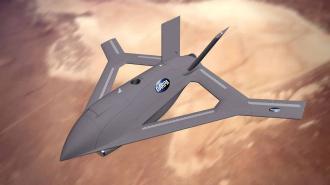DARPA is developing an experimental plane that can be steered without moving parts — and if it succeeds at the endeavor, the new type of control system could make military planes more efficient and harder for enemies to detect.
The challenge: To steer an airplane, pilots rely on the aircraft’s flight control surfaces. Movable flaps are connected to the plane’s body by hinges or tracks, and by manipulating them, pilots can control the flow of air around the plane.
To roll a plane to the right, for example, a pilot will raise a flight control surface called an “aileron” near the back tip of the right wing and lower the aileron on the left wing. This increases lift under the left wing, pushing it up, and decreases it under the right wing, dropping it down.
These systems get the job done, but they also increase drag and add to the weight of the plane, which reduces fuel efficiency. Moving flight control surfaces also makes planes easier to detect.

The idea: In 2019, DARPA — the US military agency focused on developing next-gen technologies — announced the Control of Revolutionary Aircraft with Novel Effectors (CRANE) program.
Its goal is to design and build an experimental aircraft (an “X-plane”) that uses “active flow control” to maneuver during flight, rather than traditional flight control surfaces on its wings and tail.
How it works: Active flow control systems still manipulate the air around a plane, but they do so by precisely ejecting bursts of compressed air from the body of the plane or by changing the electrical charge of the surrounding air.
Engineers have been researching active flow control for more than a century, and it has been incorporated into planes that have traditional flight control surfaces, too. Models steered by active flow control have also been flown, but no full-sized planes.
Looking ahead: DARPA has now announced that it has selected Boeing subsidiary Aurora Flight Sciences for phase 2 of the CRANE program.
During phase 1, the company built a 1/4 scale testbed aircraft that was controllable using active flow control in wind tunnel testing. During this next phase, it will design and develop the controls and software for a full-scale version of an X-plane with an active flow control system.
If DARPA likes what it sees, it could award Aurora a phase 3 contract that would fund the creation of a 7,000-pound demonstrator version of the plane. This aircraft would need to be capable of flight speeds up to Mach 0.7, and flight testing could happen as soon as 2025.
We’d love to hear from you! If you have a comment about this article or if you have a tip for a future Freethink story, please email us at tips@freethink.com.






